 Go
to the Archive index
Go
to the Archive indexFebruary 1934. A cold fog from the Thames rolls across the city, thick with the smoke from a million coal fires. Wallington makes his way along the gloomy cobbled alleyways, dimly lit by the occasional gas lamp. The damp, cloying air chills through to the soul, while in the distant darkness, the Werewolves of London howl to the night. He turns into the old Victorian industrial heartland of Park Royal, and searches for the key deep in his pocket. After fumbling at the lock, he heaves the workshop door aside, and strikes a match to light the paraffin lamp. Though the glow from its flickering wick is lost in the cavernous room, it is enough to reveal the monstrous machine standing on a plinth in the centre of the floor, the likes of which, has never been seen before! "Soon you will be finished, and the world will be ours!"
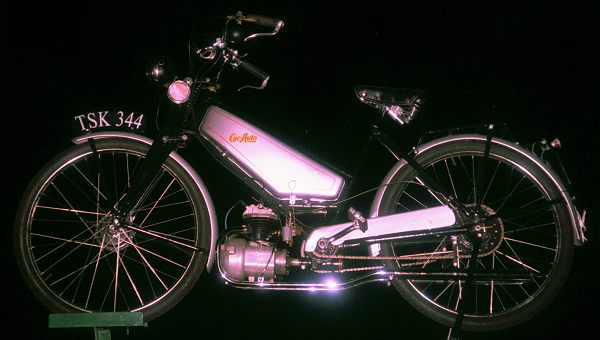
While small capacity motor cycles flourished across the continent, the
British motor taxation system of the time did nothing to encourage such
vehicles - however, the effect of Philip Snowden's budget of 1931 was
about to change all that!
The Cyc-Auto was the first of a new breed of machine, which in time, would become known as an autocycle. Since there was no established design formula, Mr Wallington Butt started with a clean drawing board to produce his own impression of how such a vehicle should be executed. This interpretation made a lot of sense in basing such a small capacity machine upon a bicycle, to be able to assist the low-powered motor in times of need. It was to be direct drive for simplicity, and utilise existing cycle principles for cheapness and practicality. Beyond this, the engineering seemed to fly off into a clear blue sky!
The 50mm × 50mm two-stroke motor of 98cc was mounted in-line, with a crank worm pinion driving a bronze gear, running on concentric bearings to the pedal shaft, within a distended bottom bracket greased housing. A separate final drive chain from the motor was taken along the left side to a rear sprocket, and though having no clutch, a dog gear allowed the engine to be disengaged. Sparks came from a Wico magneto in front of the forward flywheel, but there was no provision for lighting output. An ETC carburettor pointed from the front of the cylinder, while a rear facing exhaust port fed into a cast alloy expansion chamber between the motor and reduction housing.
The original diamond frame 'A' announced in March of 1934 was joined by a ladies open frame 'B' model for 1935, then both succeeded in 1936 by 'C' & 'D' restyled variants with lower frames, Burgess tailpipe silencing, and a change to oil lubrication for the gear housing. Three special sidecar models were also introduced to listings at this time. 1937 added a 'V' suffix to models, identifying a change to Villiers made engines with flywheel magneto.
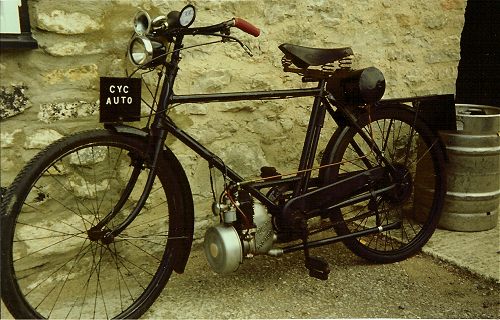
1937 Model CV Cyc-Auto
As increasing competition from other manufacturers taking up G H Jones's autocycle design licence began to bite into sales of the Cyc-Auto, the company ran into financial problems and became sold to The Scott Engineering & Motorcycle Co in 1938, who moved the business to Acton. Scott introduced a new 'J' series frame prefix, and their own engine with a clutch that was made back at the Shipley works in Yorkshire, though initially the Villiers motor remained as an option while the Scott engine was phased in.
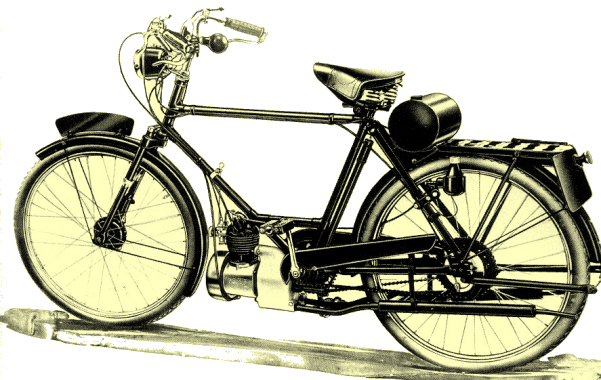
1939 Cyc-Auto
As the world situation developed into 1940 all motor cycle related activities at Scott were terminated to concentrate on "intricate mechanisms for the services", as their post-war literature proudly boasted when motor cycle products resumed in 1946. The Cyc-Auto also re-emerged after WWII, as a single model based upon the pre-war DeLuxe open frame, and still fitted with the Mk1 Scott engine.
In 1947, the one-piece cast iron head/barrel gave way to a detachable alloy head design, with iron cylinder, and two forward facing exhaust ports. For the 1949 season, a rigid-fork carrier version returned to the listings after last being available a decade earlier, and at the very reasonable price of £52-0-0, since there was the advantage of purchase tax exemption for commercial vehicles.
For 1950, there were further changes to both the engine and cycle parts, with the barrel tank finally giving way to a conventionally mounted autocycle style tank between the front downtubes. This new machine looked mighty magnificent with silver/grey mudguards, chainguard, and petrol tank lined in red, set against the black enamel frame, with sparkling chrome plated exhaust pipes, silencers, wheel rims, handlebars and fittings. The black drab of austerity was yesterday's bygone age, and the new 'Superior' model reflected the bright hopes of a new decade.
So, having travelled for 16 years with the Cyc-Auto, through all its adventures, we finally arrive at today's feature machine, a particularly striking example of the 'Superior' model, registered 28 March 1950, and listed at this time for £61-11s-11d.
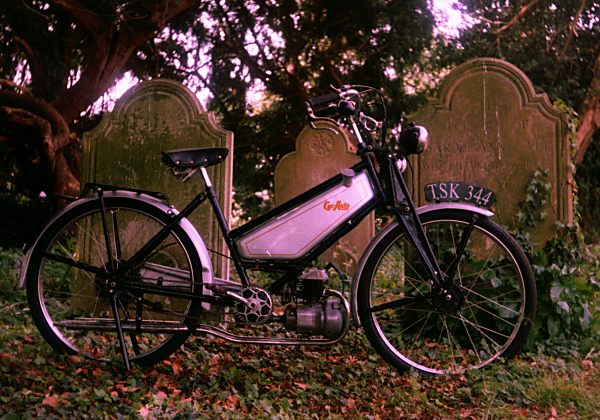
There are a few 'alien' aspects to take into account when getting going on a Cyc-Auto, starting with the switch from pedal to drive mode. A dog gear to enable the engine is operated by lateral movement of the crank axle, though the machine can still be navigated with the engine engaged by drawing the clutch. The dog gear disengages the worm drive from the crank axle to reduce pedal mode drag, though with the drive chain still idling back to the front sprocket, it's going to be a stern test of someone's fitness to pedal any real distance!
Petrol tap pulls on at bottom right of the tank, and choke operates by pulling a little rod on the left hand side. There's a flood button on the float chamber but it rarely seems necessary, and a decompressor valve in the head to help get the motor turning as you push start the machine! It may seem odd, but that's the recommended method, since the pedal-gear ratio is too high to practically start the engine without excessive effort! The other consideration against pedal starting is the three-position clutch lever! Lever released delivers conventional drive, lever engaged will slip the clutch, and lever engaged even further operates the transmission brake! Yes, there's also front and rear drums, so it really does have three independent braking systems, though you can only practically operate no more than two together at any time. Trouble with the clutch lever operation is that it's just about impossible to feel the 'neutral' point of slipping clutch, before the transmission brake starts to act, so it really is easiest to just push it off on the decompressor, then pull in the clutch once the engine fires.
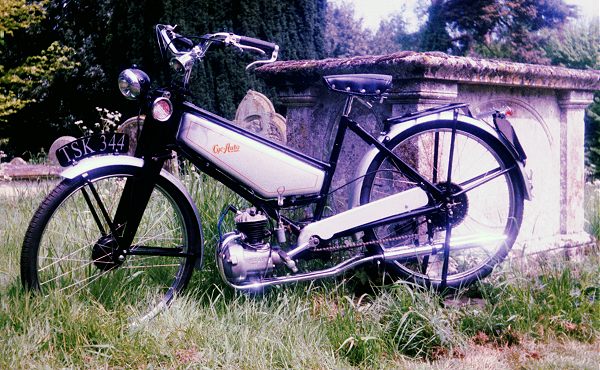
The twin cylindrical silencers generate a loud melodic resonance, very much in the classic Scott style. From a crisp barking at low revs, the note blends to a tuneful drone as the pace quickens. Acceleration is quite brisk on the general autocycle scale of such things, but seems to be explained by relatively low gearing as the bike tops out at 30mph. Happiest cruising speed is about 25mph, and pleasantly absent are the 4-stroking effects that commonly afflict many of its contemporaries; the Scott engine scavenges its gasses particularly efficiently, and rewards the discerning owner with a smooth 2-stroke ride right through its range. The low gearing and power delivery allows greater confidence when approaching hills since the Cyc-Auto seems to fear few inclines, and though probably conceding some top speed to period Villiers stablemates, a consistent average speed could more easily be maintained over general terrain, and with rather less demand for pedal assistance. All this time, you become aware of being followed by a wonderful harmonic drone from those twin exhausts, as just a tiny bit of that of that legendary heritage filters down to this humble autocycle.
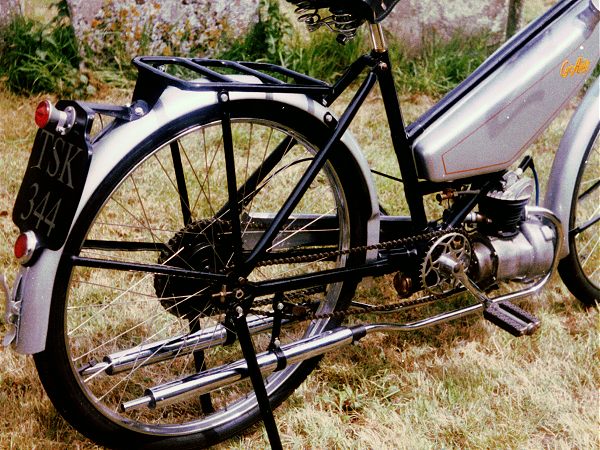
Unlike many other autocycles, the Cyc-Auto does manage to stop when you use the brakes. In fact, when you really pull on the inverted levers it actually stops very well, and might even meet the 30mph braking distances in the Highway Code book!
Handling too is pretty good, possibly helped by the low-slung power unit contributing toward a low centre of gravity?
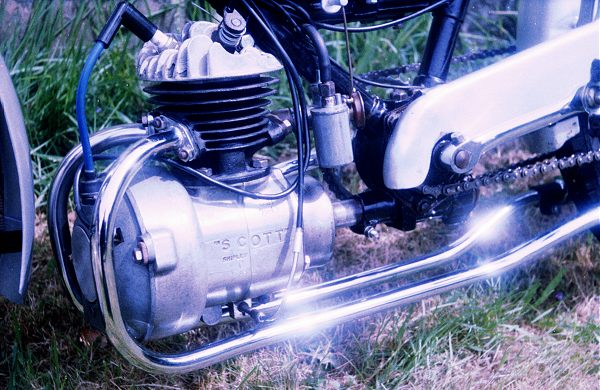
The lights though, are just farcical! This is probably the most feeble electrical set ever fitted to any autocycle! The headlamp bulb is a mere 6 Watts, and the tail lamp only 0.04 Watts! You get more energy from a candle! It actually manages to illuminate nothing at either end, but if you look carefully, you can just about detect a dim glow - that barely has the strength to make it beyond the lens! This really was the dark-age!
The Cyc-Auto came at the same price as a James 2F Superlux and a whole 1d cheaper than a Norman Model C autocycle, so it should have looked pretty tempting in any showroom line-up! So why don't we see more of them? Well, the bright hopes of the new decade didn't quite go according to plan... Scott went into voluntary liquidation in 1950, and though Matt Holder of Birmingham stepped in to buy the business, the Saltaire Works were sold and final engine assembly up to serial 8120 completed at Bingley on 27 December 1951. As the engine supply dried up, no autocycle production is recorded for years 1952 or 1953, but over this period the Cyc-Auto company was getting itself into a whole load of other problems following financial losses with development of an unsuccessful cycle attachment engine!
The Bantamoto was introduced in 1951, and despite being described as "100% British" in a rather sparse sales leaflet, like so many British cyclemotors of the period, it came from foreign ancestry. The design was by Gerd Seifert of Burscheid, a town south of Solingen in the German Rhineland. Immediately after the war, German industrial designs were made freely available to western Allied manufacturers, and while the Americans got the rocket technology - the Brits got a cyclemotor! In the American Occupation Zone of Germany, Seifert's design was taken up by Richard Küchen of Ingoldstadt and marketed as the 'Küchen 38s', while in Britain the design was acquired by the Lettington Engineering Co Ltd. of 16 Brunel Road, London W3. This company was apparently associated with, or a subsidiary of, the Scott owned Cyc-Auto Works Ltd.
The Bantamoto is a 38cc 2-stroke with rotary induction valve to the crankcase. The engine attaches to the nearside of the rear wheel spindle and drives the wheel from a pinion to an internally toothed gear clamped to the spokes of the wheel. Most Bantamoto cylinder heads were fitted with a decompressor to assist starting. The Mk1 model was single speed, but a Mk2 version later became available with a "clutch operated 2-speed gearbox and neutral", with a claimed top gear speed of 24mph, and 8mph in first. The sales leaflet describes: "The change speed is effected and designed on Epicyclic principles embodying 'Sun and Planet' gears. This system has been employed in the engineering industry for many years with great success".
Despite winning awards in the ACU's first Motor Assisted Demonstration Trial on 4th May 1952, it only followed with dismal sales over the season, some of which could be attributed to a lack of advertising in any periodicals of the time. Other issues might arise from quality concerns on the engine, which has been described by one owner as being "very poorly assembled and finished". In fact, he had to do quite a bit of machining and fitting of the innards to get it to run at all, and still required light pedal assistance all the way round the course when it last completed a VMCC cyclemotor run in the early 1980s. Following financial losses with development of this unsuccessful cycle attachment engine, by early 1953, creditors were pressing the business toward voluntary liquidation. However, salvation at the 12th hour: Cyc-Auto was saved as the business passed to Winsmiths (Finchley) Ltd, and the subsequent abandonment of the Bantamoto.
So the company staggered into 1954, when a fresh trickle of Scott engines resumed from Matt Holder's Aerco Jig and Tool Company in Birmingham, and Cyc-Auto re-awakened from suspended animation, only to find the Autocycle Age was coming to an end. Up to engine serial 8132 is recorded in 1954.
In one last flourish, a 99cc motorcycle based on the Cyc-Auto motor unit, but with shaft drive and rear plunger suspension was shown in 1955 under the Scott badge, but failed to materialise. Up to engine serial 8175 is recorded in 1955.
Still the Cyc-Auto limped along, until fading from general listings by 1956, at which date is found the highest serial identified on NACC records - engine 8182.
It is reputed that the Cyc-Auto still continued with small numbers of Superior and Carrier models in a minor form, up to 1958, when it finally fizzled out - such was the Scott way!
The peculiar engineering of the Cyc-Auto is some consideration to owning an example in the 21st century. They are extraordinary machines! A classic thoroughbred autocycle for fine appreciation of the most eccentric gentleman, and very definitely, not for the faint hearted.
Epilogue - Alfred Angus Scott was one of the great 2-stroke pioneers and built many race winning machines, including the 1912 & 1913 Isle of Man Senior TTs. He sold his stake and left the company after WWI, to pursue interests in his odd three-wheeled Scott Sociable car. It never caught on and he died of pneumonia in 1923.
Next - An incredible 'must do' double test of fiercely comparative machines from just marginally different generations, so they never actually clashed in the market place. Finally, Buzzing gets them together, and the clue is - Two Dogs!
First published, June 2005